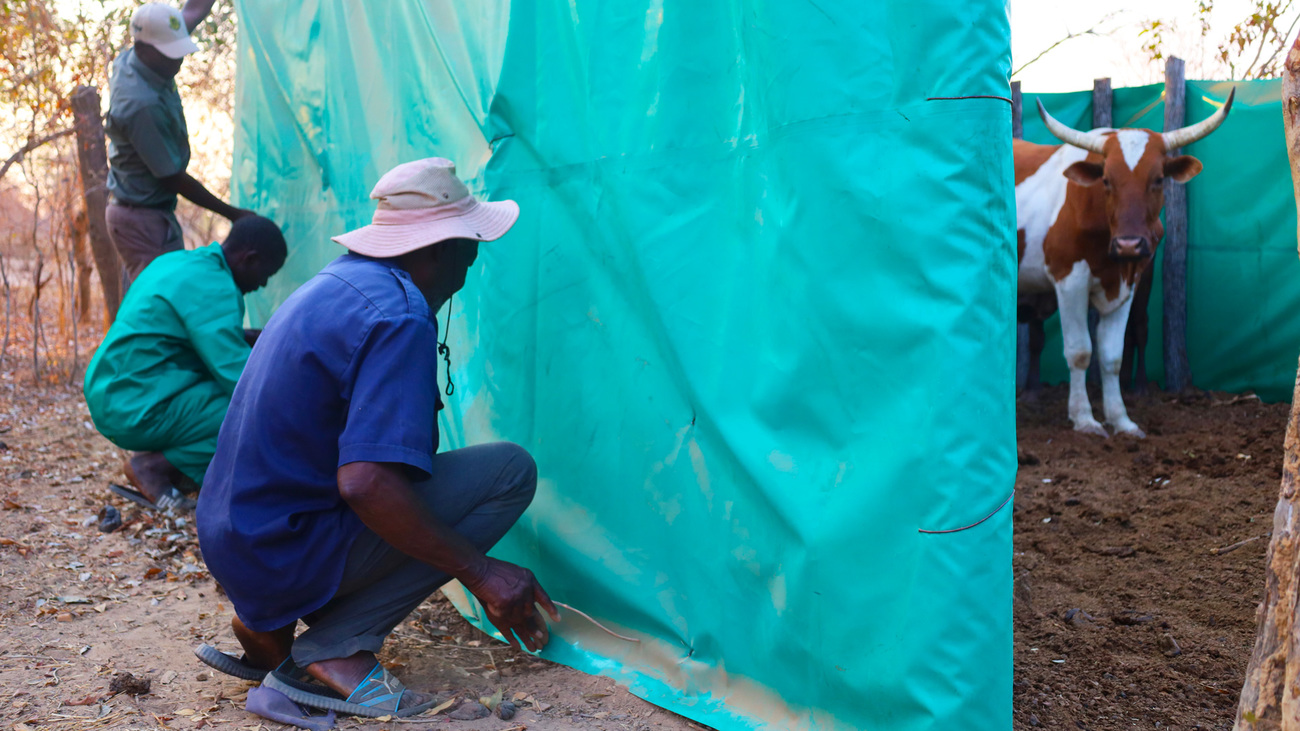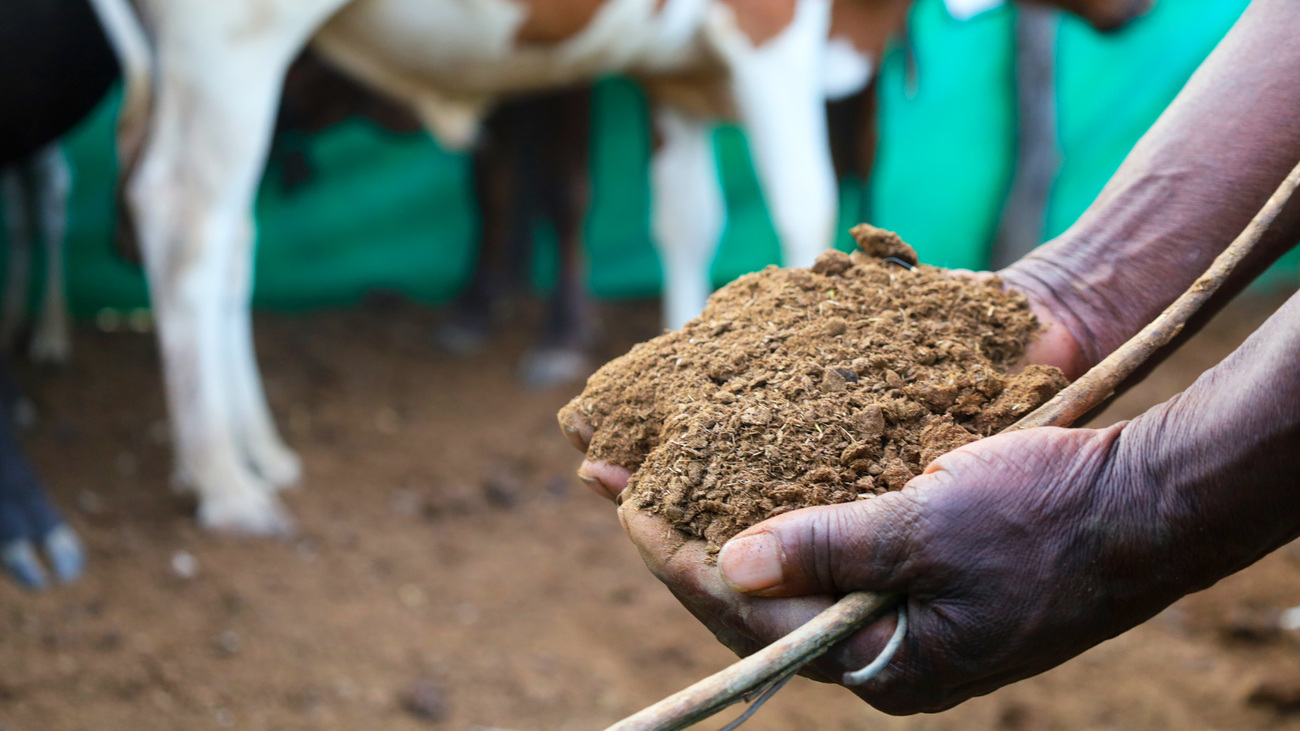Protecting lions and cattle with innovative bomas
Protecting lions and cattle with innovative bomas

Any cattle farmer living near wildlife will tell you livestock are hard to protect—particularly after dark. Even when cows are corralled together in a sturdy boma—an enclosure traditionally made of wooden poles and thorny acacia branches— they remain a target for hungry predators.
Recently, conservationists discovered that while traditional sturdy bomas are not always a reliable way of keeping cattle safe from lions, cheetahs, and hyenas—a simple opaque plastic sheet supported by posts can do the job. In the communities close to Hwange National Park, Zimbabwe’s largest protected area, IFAW, in partnership with ZimParks and the Wildlife Conservation Research Unit (WildCRU), is promoting the use of predator-proof mobile bomas, a simple yet innovative conservation initiative which uses thick plastic sheeting to help curb human-lion conflicts.
The mobile predator-proof bomas are designed to be easily assembled or disassembled and moved from one crop field to another.
‘After over 20 years studying lions in southern Africa, we have discovered that lions are visual hunters,’ says Liomba-Junior Mathe, Lion Guardians Manager for WildCru’s Trans-Kalahari Predator Programme. ‘When they hunt, they must visualize and select their prey before launching an attack. So, once you put a barrier in front of them, they do not know what to do.’
In the Hwange and Tsholotshlo districts, this project is helping reduce cases of livestock predation, enhance food security, and promote peaceful coexistence between people and wild carnivores.
In Kenya, where the Maasai community has long relied on livestock as their primary source of livelihood, predator-proof mobile bomas have proven effective in preventing carnivore incursions and enhancing the economic status of buffer communities.
‘The concept behind the bomas is that predators do not have visual access to livestock when enclosed in the boma; hence, they cannot trigger stampeding of livestock out of the bomas,’ Liomba describes.
In Hangano village, a small rural community sharing the fragile frontier with Hwange National Park, five predator-proof bomas have been deployed, and the results have been encouraging.
‘We can now sleep peacefully, knowing that our livestock are safe,’ says Albert Moyo, Hangano village head. ‘The benefits are immense, and already we are witnessing a drastic reduction in livestock predation.’

“The net effect of such an innovative conservation initiative is a positive attitude towards wildlife,” Albert adds.
According to WildCRU, there has been a 50-90% reduction in livestock predation in other parts of Hwange District where predator-proof mobile bomas have been deployed.
Reducing human-wildlife conflict
Hwange National Park is home to at least 500 lions tussling for every square inch of the park, and it is studded with prey for these apex predators.
But this otherwise impressive habitat is shrinking fast. It is subjected to immense pressure from human activity, and the consequences of climate change have increased contact between lions and communities, which results in lions preying on livestock.
It is estimated that more than 150 head of cattle were killed by lions between 2020 and 2022 in Zimbabwe’s Hwange District. As a result, disgruntled farmers often kill lions in retaliation, pushing the species closer to extinction.
Protecting cattle through predator-proof mobile bomas has great potential to reduce human-wildlife conflict—they’ll protect people’s livelihoods and lions, too.
‘IFAW’s long-term vision for the Hwange-Matetsi-Zambezi landscape is to ensure communities have sustainable solutions to reduce human-wildlife conflict and promote coexistence,’ said Simbarashe Chiseva, IFAW Community Development Officer.
Enhancing crop yields
When placed in crop fields with a carrying capacity of around 40-60 cattle, the predator-proof mobile bomas also help improve soil fertility.
Cattle help to fertilize soil by breaking down topsoil with their hooves, in addition to depositing their dung and urine. The bomas are then rotated between arable fields every 2-3 weeks to facilitate the fertilization of multiple crop fields.
‘It is my wish that project partners expand this initiative to cover all the other villages bordering the national park so they, too, benefit from this transformative concept,’ Albert says.
The IFAW-ZimParks partnership has installed 18 predator-proof bomas in selected villages bordering Hwange National Park.

The world’s apex predator is under siege
Lion populations are shrinking at an alarming rate. It is estimated that only 20,000 lions remain in the wild today, while there were 200,000 in 1975. The species is now classified as vulnerable by the IUCN.
While one of their primary threats is habitat loss, another major cause of lion population decline is retaliatory killings.
Not only do lions symbolize bravery and leadership in traditional cultural beliefs, but they also play a significant ecological role in managing large herbivore populations. However, in the eyes of the impoverished rural communities living adjacent to protected areas, where livestock are highly valued livelihood assets, lions are notorious pests. Cattle and goats are important to farmers’ livelihoods.
The dilemma conservationists face is how to create an environment where communities can safely share their land with these predators. Predator-proof bomas are one promising solution.
Related content
Our work can’t get done without you. Please give what you can to help animals thrive.